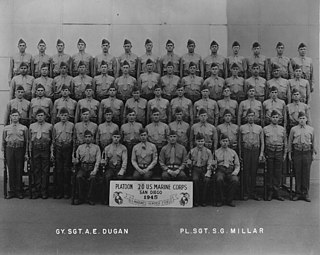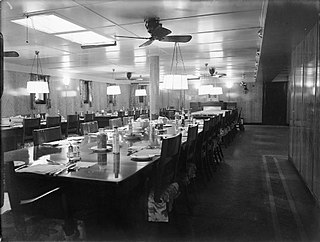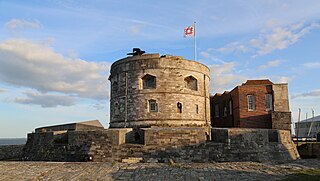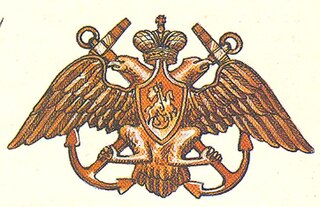Warrant officer (WO) is a rank or category of ranks in the armed forces of many countries. Depending on the country, service, or historical context, warrant officers are sometimes classified as the most junior of the commissioned officer ranks, the most senior of the non-commissioned officer (NCO) ranks, or in a separate category of their own. Warrant officer ranks are especially prominent in the militaries of Commonwealth nations and the United States.

A platoon is a military unit typically composed of two to four squads, sections, or patrols. Platoon organization varies depending on the country and the branch, but a platoon can be composed of 20–50 troops, although specific platoons may range from 10 to 100 people. A platoon is typically the smallest military unit led by a commissioned officer. The platoon leader is usually a junior officer—a second or first lieutenant or an equivalent rank. The officer is usually assisted by a platoon sergeant.

The wardroom is the mess cabin or compartment on a warship or other military ship for commissioned naval officers above the rank of midshipman. Although the term typically applies to officers in a navy, it is also applicable to marine officers and coast guard officers in those nations that have such service branches. On larger vessels, such as aircraft carriers of the United States Navy, there may be more than one wardroom. It may also be used on stone frigates to refer to similar officer mess facilities at naval, marine, and coast guard installations ashore.

The mess is a designated area where military personnel socialize, eat and live. The term is also used to indicate the groups of military personnel who belong to separate messes, such as the officers' mess, the chief petty officer mess, and the enlisted mess. In some civilian societies this military usage has been extended to the eating arrangements of other disciplined services such as fire fighting and police forces.
Prize money refers in particular to naval prize money, usually arising in naval warfare, but also in other circumstances. It was a monetary reward paid in accordance with the prize law of a belligerent state to the crew of a ship belonging to the state, either a warship of its navy or a privateer vessel commissioned by the state. Prize money was most frequently awarded for the capture of enemy ships or of cargoes belonging to an enemy in time of war, either arrested in port at the outbreak of war or captured during the war in international waters or other waters not the territorial waters of a neutral state. Goods carried in neutral ships that are classed as contraband, being shipped to enemy-controlled territory and liable to be useful to it for making war, were also liable to be taken as prizes, but non-contraband goods belonging to neutrals were not. Claims for the award of prize money were usually heard in a prize court, which had to adjudicate the claim and condemn the prize before any distribution of cash or goods could be made to the captors.

Calshot Castle is an artillery fort constructed by Henry VIII on the Calshot Spit, Hampshire, England, between 1539 and 1540. It formed part of the King's Device programme to protect against invasion from France and the Holy Roman Empire and defend Southampton Water as it met the Solent. The castle had a keep at its centre, surrounded by a curtain wall and a moat. Initially heavily armed, it had a garrison of 16 men and as many as 36 artillery guns. The castle continued in use for many years, surviving the English Civil War intact and being extensively modernised in the 1770s. During the 19th century, Calshot Castle was used by the coastguard as a base for combating smuggling. In 1894, however, fresh fears of a French invasion led to it being brought back into use as an artillery fort: a large coastal battery was constructed alongside the older castle and a boom built across Southampton Water, controlled from the castle.
Holland & Holland is a British gunmaker and luxury clothing retailer based in London, England, which offers handmade sporting rifles and shotguns. The company holds two royal warrants.

The Imperial Russian Navy operated as the navy of the Russian Tsardom and later the Russian Empire from 1696 to 1917. Formally established in 1696, it lasted until dissolved in the wake of the February Revolution of 1917. It developed from a smaller force that had existed prior to Tsar Peter the Great's founding of the modern Russian navy during the Second Azov campaign in 1696. It expanded in the second half of the 18th century and reached its peak strength by the early part of the 19th century, behind only the British and French fleets in terms of size.

The Fusiliers marins are specialized sailors of the Marine nationale. The Fusiliers marins serve primarily as the Navy’s security forces, providing protection for naval vessels and naval installations on land. Created in 1856 and with a modern strength of about 1,800 personnel, the Fusiliers marins should not be confused with the larger Troupes de Marine of the Armée de terre whom are often referred to as the French ‘marines.’
Seafaring is a tradition that encompasses a variety of professions and ranks. Each of these roles carries unique responsibilities that are integral to the successful operation of a seafaring vessel. A ship's crew can generally be divided into four main categories: the deck department, the engineering department, the steward's department, and other. The reasoning behind this is that a ship's bridge, filled with sophisticated navigational equipment, requires skills differing from those used on deck operations – such as berthing, cargo and/or military devices – which in turn requires skills different from those used in a ship's engine room and propulsion, and so on.

The Japanese raiders in the Indian Ocean were those vessels used by the Imperial Japanese Navy (IJN) during the Second World War to pursue its war on Allied commerce in that theatre. Possessing a powerful fleet of warships, prior to the start of World War II, the IJN had strategically planned to fight a war of fleet actions, and as a consequence delegated few resources to raiding merchant vessels. Nevertheless, in 1940, two passenger-cargo vessels – Aikoku Maru and Hōkoku Maru – of the Osaka Shipping Line were requisitioned for conversion to armed merchant cruisers (AMC)s, in anticipation of the likely thrust southward by the Japanese. These vessels were subsequently used as merchant raiders attacking Allied commercial shipping along vital sea lanes of communication between Australia and the Middle East. Using their comprehensive armament and speed to their advantage, the raiders experienced a brief period of success. Japanese raiding in the Indian Ocean largely ceased by the end of 1942 after an action with a Dutch vessel, the Ondina and a Royal Indian Navy corvette, HMIS Bengal in which the Hōkoku Maru was sunk.

The Cocos Islands mutiny was a failed mutiny by Sri Lankan soldiers against British officers, on the Cocos (Keeling) Islands on 8 May 1942, during the Second World War.

'Warwick Camp' was originally the rifle ranges and a training area used by units of the Bermuda Garrison based elsewhere in the colony. Today, the Camp is the home of the Royal Bermuda Regiment.
Commander (Cdr) is a senior officer rank of the Royal Navy of the United Kingdom. It is immediately junior to captain and immediately senior to the rank of lieutenant commander. Officers holding the junior rank of lieutenant commander are not considered to be commanders.

The master, or sailing master, is a historical rank for a naval officer trained in and responsible for the navigation of a sailing vessel.
Master's mate is an obsolete rating which was used by the Royal Navy, United States Navy and merchant services in both countries for a senior petty officer who assisted the master. Master's mates evolved into the modern rank of sub-lieutenant in the Royal Navy, while in the merchant service they evolved into the numbered mates or officers.

The First Battle of Cárdenas was a naval action fought in May 1898 during the Spanish–American War. A force of three Spanish vessels attempted to lift the blockade of Cárdenas but were repulsed and sent back into harbor by two United States Navy warships.

Royal Navy ranks, rates, and uniforms of the 18th and 19th centuries were the original effort of the Royal Navy to create standardized rank and insignia system for use both at shore and at sea.
A mate is a deck naval officer aboard a merchant vessel, such as the chief mate, second mate, or third mate. Between 1800 and 1890 "mate" was also the naval rank now known as sub-lieutenant—master.

Artillery Memorial, Cape Town was erected in memory of the gunners who fought for South Africa during World War I. The memorial, which forms part of the Delville Wood Memorial, is located in the Company's Garden, Cape Town, and was strategically established to commemorate South Africa's artillery soldiers who fell in battle. Of those who volunteered to fight during the war, 5800 were white South African, amongst whom 15% were Dutch and 85% English. An estimated 2536 of these men were killed in the Deville Wood battle in Europe. The Artillery Memorial, an authentic cannon facing east towards the National Gallery, proudly honors South Africa's heavy artillerymen. Inscribed on it are the names of the officers, N.C.O.'s and men of the South African artillery who fell in the Great War (1914–1918).













